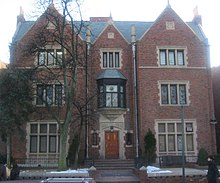Chabad
![]()
The neutrality of this article or section is disputed. A justification can be found on the discussion page in the section "NPOV". For more information, click here.
Chabad (Hebrew: חב״ד) or Lubavitch (Yiddish: ליובאוויטש, Ljubavitch) is a Hasidic grouping or dynasty within Orthodox Judaism founded by Rabbi Schneur Salman of Ljadi (1745-1812) in the late 18th century. Followers of the movement are referred to as Lubavitcher or Chabad Hasidim.
The dynasty is named after the village of Lyubavichi (Russian Любавичи), a village near Smolensk in far western Russia, historically located in the Grand Duchy of Lithuania, which was the center of the movement from 1813, when the second Rebbe of the Chabad dynasty Dov Ber settled there, until its evacuation in 1915 in the turmoil of World War I. Its current center is in the residential neighborhood of Crown Heights in the borough of Brooklyn, New York.
Chabad", an acronym from the Hebrew Chochma (חכמה, "wisdom"), Bina (בינה, "knowledge, understanding") and Daat (דעת, "knowledge"), is the name given to Hasidic groups for whom these three terms (Sephiroth) from the Kabbalah are of central importance.
Chabad Lubavitch, through its institutions and emissaries (shluchim), is present in some 70 countries. The number of followers is about 17,000 families, although several thousand non-religious Jews also occasionally participate in Chabad activities.

Chabad Lubavitch Headquarters in Brooklyn, New York
Basic
The various groups of Hasidism traditionally differ in their emphasis on different areas in the service of God. Chabad particularly emphasizes contemplative prayer and the intensive, systematic study of Hasidic doctrine. Since Rabbi Menachem Mendel Schneerson, significant efforts have also been made to ‑bring Torah teaching ‑to non-observant Jews.
In common with other Hasidic groups, Chabad philosophy emphasizes the service of God with joy (Hebrew simcha) and the task of man to release the indwelling divine sparks (Hebrew nitzotzot) through the use of material goods (this process is called Tiqqun Olam in Hebrew).
The Chabad headquarters was located in Lyady under Schneur Salman; under his son and successor, R. Dowber, the headquarters was moved to Lubavitch. After the evacuation of Lubavitch during World War I, the Chabad Rebbes lived in Rostov-on-Don, Riga, and Warsaw until Rabbi Yosef Yitzchak Schneersohn fled to the United States in 1940. He settled in the Crown Heights (Brooklyn) neighborhood of New York, where his successor Rabbi Menachem Mendel Schneerson also lived until his death.
The Central Chabad Synagogue, also located in Crown Heights, is also called 770 after its address, "770 Eastern Parkway."
Reliable data on the number of members of the Chabad movement are not available.
The book Tanja
The Book of Tanya by Schneur Salman is the central work of Chabad Hasidism. It first appeared in Slawita in 1797. The name "Tanja" derives from the Talmud passage quoted at the beginning of the book, which begins with the word Tanja ("we have learned"). In today's printed editions, the Book of Tanja comprises five separate parts:
- Likkutej Amarim, also called Tanya or Sefer Shel Bejnonim ("The Book of Average People").
- Shaar HaJichud WeHaEmuna ("Gate of Unity and Faith")
- Iggeret HaTeshuva ("Letter about the Return")
- Iggeret HaKodesh ("Holy Letter")
- Kuntres Acharon ("Last Treatise")
The name Tanja is now used to refer to the entire book, not just Part I.
- In Part I (53 chapters), as indicated in the subtitle "The Book of the Average Man", the main theme is the average man (Hebrew Bejnoni) and his spiritual potential. According to R. Schneor Salman, the Bejnoni succeeds in sinning neither in thought, word, nor deed. However, despite the Bejnoni's outward control over these areas, the potential for evil remains in full force and requires constant vigilance and combat. According to R. Schneor Salman, the personality of the Bejnoni is not a mere ideal, but is practically attainable by everyone.
- The basis for Part II Shaar HaJichud WeHaEmuna (12 chapters) is one of the main theses of R. Schneor Salman: that faith and knowledge are necessary complements to properly serve God. Man must struggle to the limits of his own intellectual capacity to understand divinity and only beyond that limit apply faith. Part II deals, among other things, with the topics of "creation out of nothing", divine essence and emanation, and tzimtzum (Hebrew "reduction", "condensation").
- Part III, Iggeret HaTeshuva (12 chapters), deals with the topic of teshuva (Hebrew: "repentance", "return"). In R. Schneor Salman, the term teshuva receives a multifaceted interpretation: from the turning away from apparent evil to the spiritual further development of good.
- Part IV, Iggeret HaKodesh, was added posthumously by the author's sons and contains 32 letters that are unrelated in content. Some of the letters refer to themes in Part I of the Tanja. The commandment of charity (Hebrew zedaka) is a dominant theme. In addition, the necessity of studying the mystical dimension of the Torah and a detailed justification of Hasidic doctrine are addressed.
- Part V, Kuntres Acharon (9 treatises), was also published posthumously by the author's sons. The treatises in this part are not related to one another in terms of content and deal for the most part with complex theories of Kabbalah. However, the last two treatises (nos. 8 and 9) contain practical instructions for daily prayer, the instruction to learn the halachot (Hebrew "laws") of the Sabbath every Shabbat, and at the same time to guard the Sabbath not only according to the law, but also in its inner dimension.
The study of Hasidism in general and the "Book of Tanja" in particular is an important part of study for Chabad Hasidim. A German translation of all five parts of the "Book of Tanja" was published in Vienna in 2000. Further editions followed.
Search within the encyclopedia